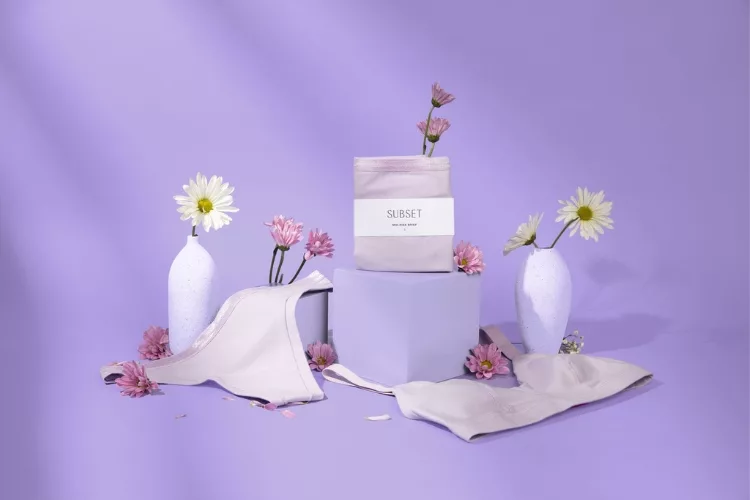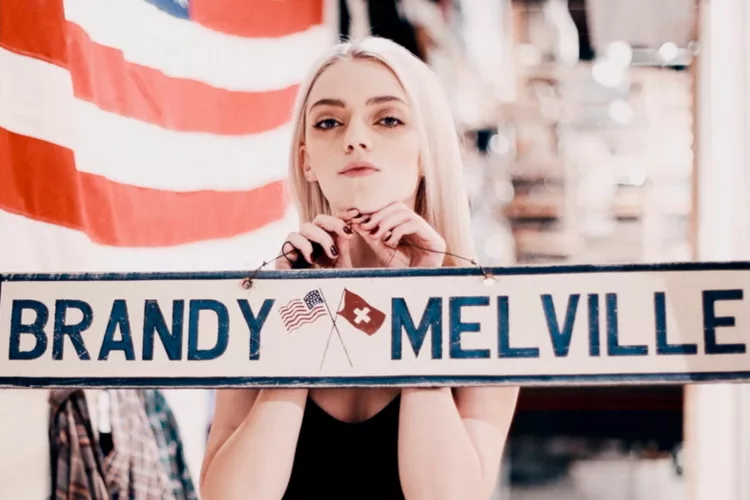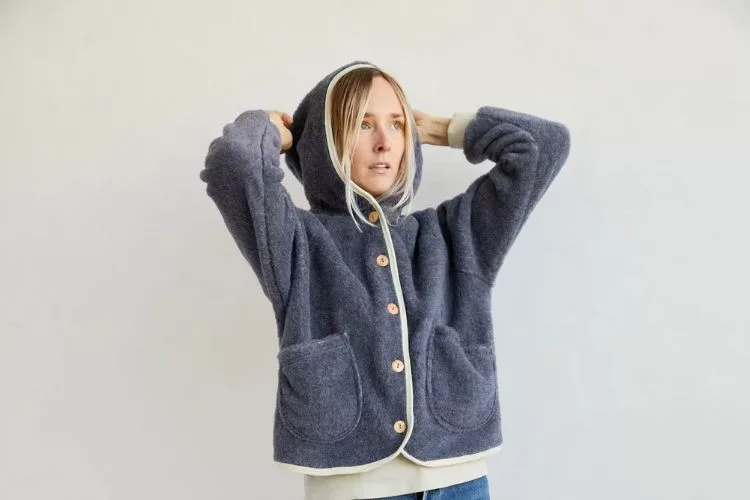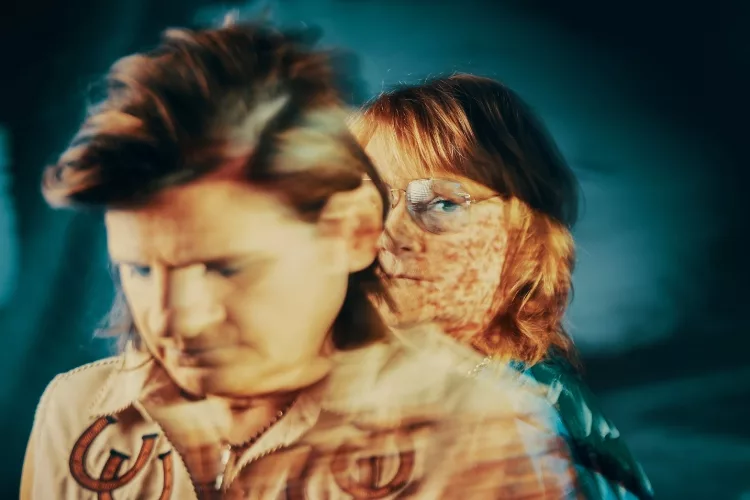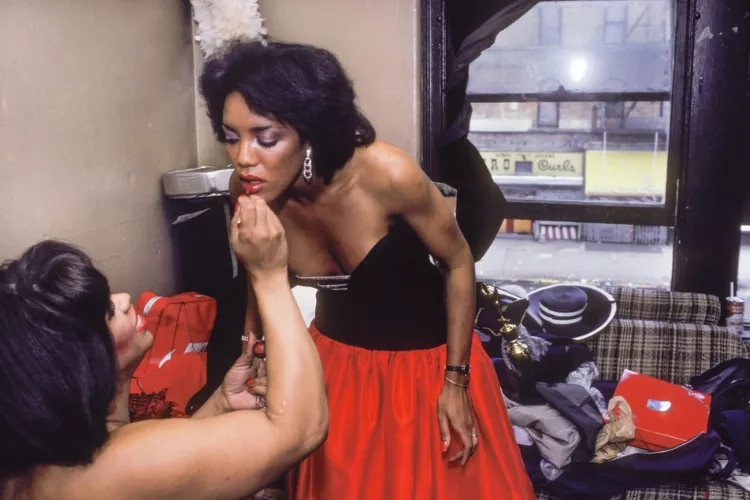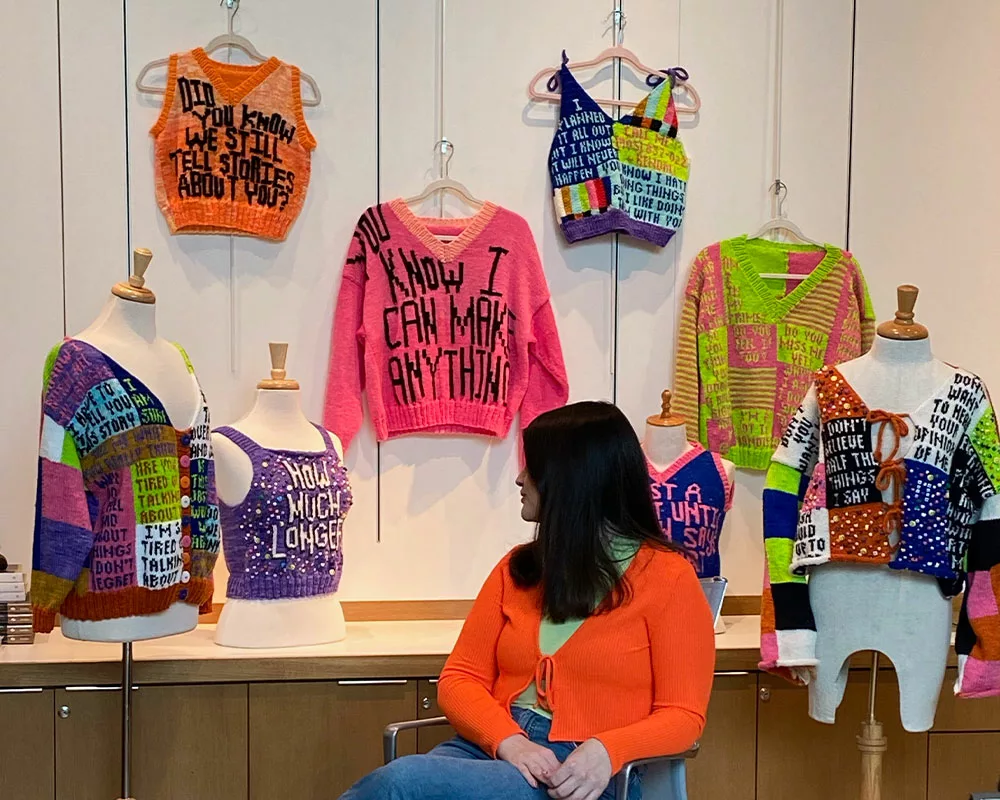
When we came across the indie knitwear label id.knit.that, the name made us smile. We were delighted to discover the name represented an array of vivid knitwear decked out with equally quick-witted slogans. The sweaters, handcrafted by Kendall Ross in Oklahoma City, are the sorts of garments with lives of their own, each evoking a unique character and experience. We got the chance to sit down with Kendall and chat about her process. Read the interview to learn how she got here, what inspires her, and how she went from making “women’s work” to creating art.
Steph/NKM: it’s such a pleasure to meet you Kendall, we’re huge fans of your knitwear! You studied history in college. How did that lead to a career in knitting?
I’ve been knitting my entire life. My grandma taught me the basics of crochet, such as how to train. But she didn’t like me using up her yarns and so she would undo everything I made. I would just do more. I learned a lot from her and ever since then, I’ve been drawn to fiber, arts, knitting, crochet, all of that.
I learned early on that I love the process of making things – both the execution and having something tangible at the end. Part of why I was so drawn to knitting is that it’s something that came from my family. My early memories of knitting are memories of being with my mom, my grandma, my aunts, all of these women making things together, telling stories and laughing.
So as I developed this love for knitting, I developed a love for storytelling alongside it, which influenced my decision to study history. I was knitting throughout high school, but I didn’t consider myself an artist – people called me crafty, but there was no concept in my mind that art school was an option, or that I could make a career out of it.
I studied American history after high school. I focused on women’s history and dabbled in some courses for fashion and textile history. My thesis focused on women’s knitting movements during World War One. Throughout college I was making things, and getting my friends together to knit. Knitting and creating were big parts of my life throughout college, I just didn’t officially study art or design.
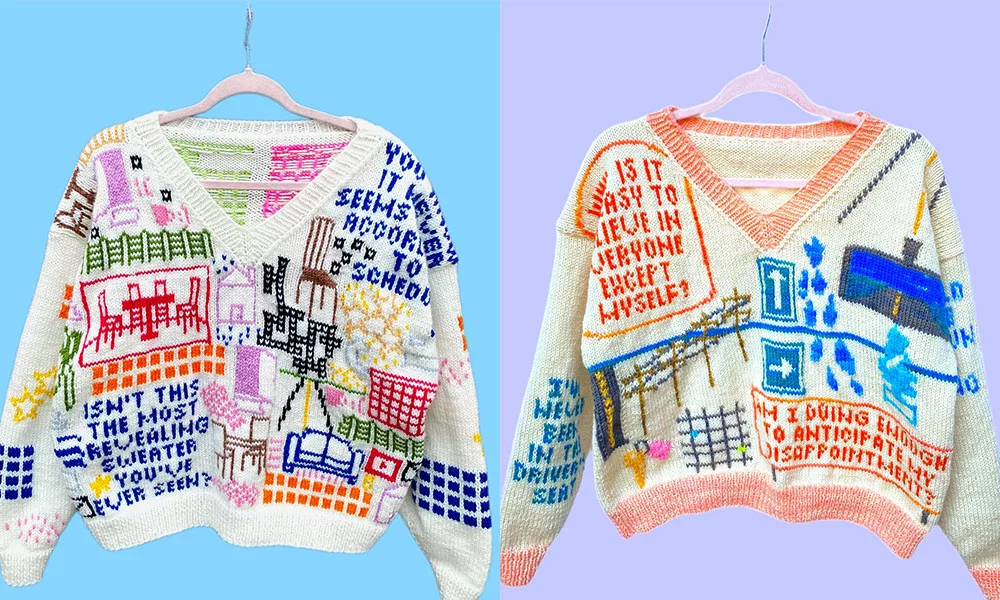
So you’re entirely self-taught?
I took one art class during college–a Zoom sculpture class during the early days of the pandemic. The lowest project grade I got over those four years was for a sweater I made as a sculpture. I’m still bitter about that. [laughs]
I bet that sculpture teacher feels bad now.
Maybe! But you never know. I sometimes ask myself whether I should go to grad school. But then I wonder if I’m just looking for validation, you know, that piece of paper on the wall. But ultimately I don’t think that’s what matters.
Your grandmother taught you early. Did you have any other female role models or mentors that helped you get where you are today?
Absolutely. My grandma and my mom have always been an inspiration, people who are constantly making things. [hands go into sewing machine motions here] They love to make things for other people. My grandma taught me how to crochet. I attempted to teach myself knitting when I was probably 10 or 11. I was in middle school and I tried to learn from YouTube using a beginner sewing kit that my mom had gotten from T.J. Maxx. But I was getting so frustrated and yelling at the screen and she couldn’t handle any more of my drama, so she took me to a local yarn store in Oklahoma City called Gourmet Yarn Company (it’s closed down since). Margaret, the owner, taught me the basics of knitting; she was impressive and could make anything.
I actually ended up working at the store for a couple of years before I went off to college, and she called me Kendra for the whole time, so I don’t know if she remembered having taught me originally. But she was great. Working there was inspiring, watching groups of women come in, sit in the back, laugh together, knit together, and make things. I got a lot of the skills that I needed to be successful professionally. I learned about tools, fiber, how to read charts and patterns.

It seems like half the internet has taken up knitting and crocheting recently. Why do you think people are so drawn to it at this time?
I think part of it is that people want to move away from fast fashion. That’s my first thought – people don’t want to support the exploitation that comes with cheap, mass production. Having the ability to make your own clothes is cool, and it’s empowering.
Another part is people being more open to sharing the things that they’re making and doing–being more confident of traditionally feminine things that in the past might have been considered silly, but are now at the forefront of fashion. And I think social media really inspires people when they see things like, I want to make that too.
You don’t have to be perfect and you don’t have to be a professional.
Absolutely. And I think that’s great. Working with the yarn store, I learned so much, but everything was technical, with set rules. It’s as if there was some governing body of knitting that established what you had to do and how you had to do it. I think turning away from that has allowed people to be more creative.
Having said that, your work is, well, pretty perfect! Do you have any advice for people just starting out?
The market has gotten really saturated. You have to find a way to be unique and set yourself apart. My advice is to give yourself time to do that. Anyone can knit. The challenge is figuring out your own style and practice as an artist or a designer–how to do it in your own way so people can look at that and go, “Wow, I know Kendall made that.” That takes time. When I was in college, I made things that looked like what other people made. It’s taken years, but I get better every day.
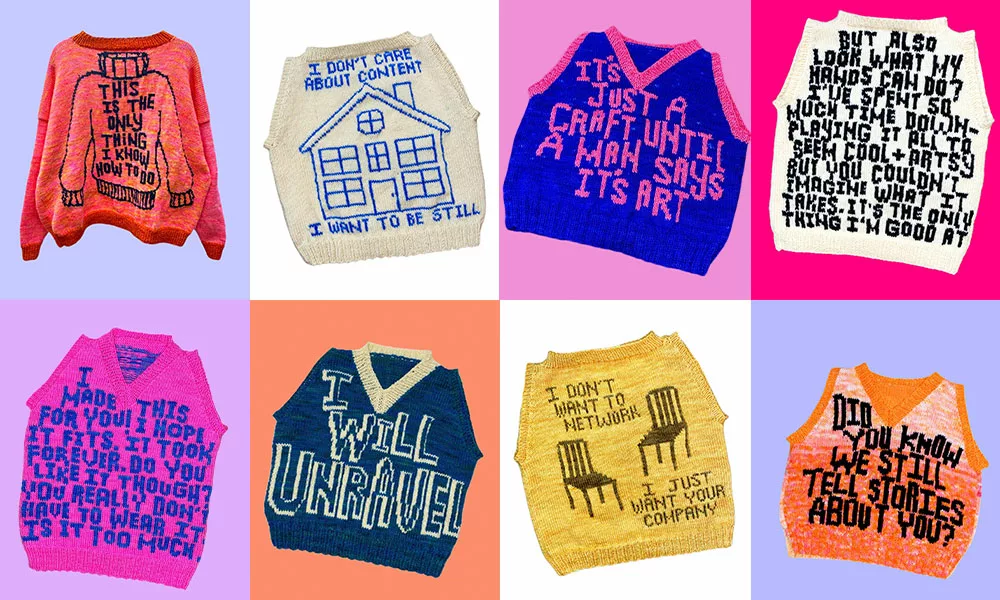
Your affinity for storytelling really comes through in the work, it seems like there’s an experience behind every piece – is that accurate?
Oh, for sure. Part of what I love about knitting is that it is a way to convey a lot of things in very condensed space, to tell a story that people can read in different ways, but in the form of this thing that you can hold or put on your body.
Take us through the creative process of making a sweater, from inception to execution.
I keep a lot of notes on my phone because my work incorporates text and images, and I start from there. The text usually comes from some sort of experience. The next step is to create the pattern in the color work for the knitting. I use a website; it’s basically digital graph paper and I’ll go in and plug in every stitch that needs to be red or white or blue or whatever. From there I’ll just start knitting. I use mainly wool yarn. I used to have trouble finding colors that I liked, so now I hand-dye most of my wool. I’ll start with bare wool and dye everything into the colors I want.
How important is color to you?
I love color and I love putting colors together. I love a black and white piece too, especially with texture. But I’ve always been inspired by what different colors mean to me and what they mean together.
There have been times in my life when I’m making a sweater for somebody, and I think, I would be the color pink but this other person would be blue, and a third person green. But I’m always pink!
That reminds me of synesthesia, like when people hear music and see colors.
I would love to lie and say I have that, but I don’t.
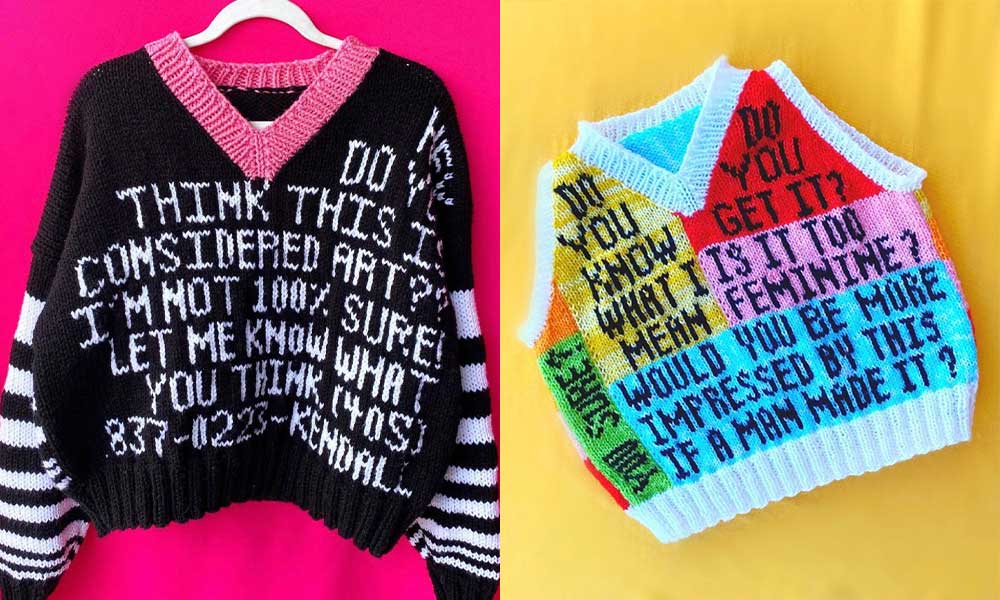
People would believe you if you said you did though. You have such intelligence for color! Let’s circle back to something you touched on earlier – this idea of a distinction between crafters and artists.
Absolutely. It’s very gendered. I know a lot of people who call knitting a craft and call themselves crafty, and that’s their thing and they own it.
But when a man calls it a craft, I think, Are you saying that because you’ve placed it below what you consider art? So at some point, I made a conscious choice to stop calling it crafts.
A lot of practices that are traditionally considered “women’s work” –knitting, nursing, teaching– are undervalued. I’m not saying I do the same thing as a nurse does, but we tend to get grouped into the same domain based on the fact that our professions are dominated by women. I never call myself crafty anymore, because I want to be in that art space. Now I say I’m an artist. It’s about owning it and thinking about how much skill and artistic ability it takes to do it well. It’s crazy that a simple choice of words adds value to my work, but I think it really does.
Word choice makes a big difference. I’d Knit That is a great name. How did you come up with it?
I’ve always loved Pinterest. I’m a Pinterest girl. And in college, I decided I needed to make my Pinterest board names a little bit more clever. One day I came up with that name for a board, but it was during my sophomore year while I was abroad and wasn’t knitting much. I was busy trying to survive in Shanghai, and I thought to myself, when I get back I need to knit, and I need to use that name. And so I went on Instagram and claimed the handle. I didn’t use it for months, it just sat there, but I knew I needed to lock it down.
What was Shanghai like?
I was there from September 2018 to April 2019. I loved it. I love China. My Chinese is very bad, but most people in Shanghai spoke English. I’m glad I got the experience. It doesn’t necessarily directly impact my work. But just the experience of being so far away made me want to come home, so that definitely influenced my decision to move back to Oklahoma City after college.
Is there a big fashion / art scene in Oklahoma?
There’s definitely a lot of art. I love being near my family. I learned early that this was something that’s very important for me. There are so many good people who are working so hard to create opportunities for people, to bring in new people, to collaborate. I love living here and I love the people. It’s very different from what most people think. Rent is obviously much lower here as well.
You said your mom and grandma helped you out a lot in the early days. Do they still play a big part in your making process?
My mom is the greatest woman alive. She helps me constantly. Anything I need. My sister-in-law is also one of my best friends and she helps me constantly. So that’s been one of the good things about staying in my hometown. I don’t know how that would be possible if I was living in, say L.A. or New York.

In your collection, are there any pieces that you’re particularly proud of? I love everything, but there are some pieces that are just majestic, like that huge oversize sized sweater…
That one took forever. Right now I’m in a phase where I’m making pieces that include a little bit of text and a lot of image. And I think those are my favorite right now. But I also don’t get very attached. I don’t really wear any of my own pieces. They take so much out of me that when I finish one I’m like, someone get this away from me! I never want to see it again!
Over the last year, I’ve reached the point where I’m so proud of what I’m making that I know I’m in my own class. That’s given me confidence in allowing myself to experiment, to make whatever I want, and also not be as insecure about other people. I’m able to appreciate other artists more now, because I have more confidence in my own work.
Whose work do you find exciting?
Alexandria Masse. She does mainly crochet. I love her work and find her so inspiring. The thing we were talking about, about not calling yourself an artist? She’s always been so bold about that. And also telling people “I’m not going to work for free. You can’t take my photos, you can’t rip off my work.” And lots of other artists.
Right now I’m inspired by ceramic pieces. People have made those really unique, hand-painted ceramics. They’re so impressive. I’m obsessed with them, because I’m taking a ceramics class and I’m really bad at it.
I think going beyond your comfort zone is really where the inspiration comes from. Even if the things you’re making don’t look the way you first envisioned them, it’s so important to remember that they still have value.
-Steph Lawson
RELATED ARTICLES

